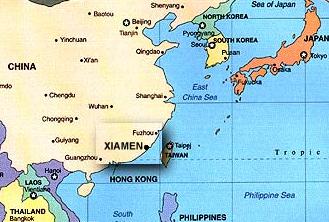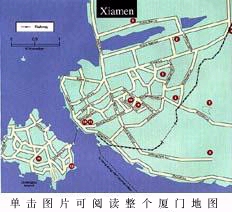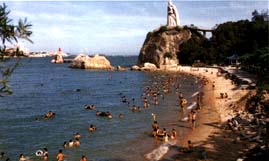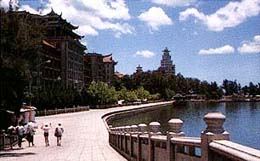|
OverviewXiamen, China's cleanest, most beautiful, seaport city, is located on the southeastern coast of Fujian Province. Xiamen City, as an administrative unit, can be dated back as far as the Song Dynasty. It has always been an important trading port, but since its establishment as one of China's first four Special Economic Zones in 1981, Xiamen has become a "window city" for China's opening to the outside world. It's one of the municipalities approved by the State Council of the People's Republic of China, being specially designated under separate state plan and enjoying provincial level of power in economic management. Today, Xiamen is a rapidly growing city, with a vigourous economy and a fully-modern infrastructure. Over the past 10 years, Xiamen has increasingly focused on the cultivation of international trade, education, and tourism. |

 Situated at longitude 118 04'04"E, by
latitude 24 26'46" N., Xiamen consists of Xiamen Island,
Gulangyu Islet, and the coastal part of the north bank of inland
Jiulongjiang River, covering an area of 1,516 sqkm. Built in
1955, the Gaoji (Gaoqi-Jimei) Causeway has turned Xiamen Island
into a peninsula by linking it with the mainland.
Situated at longitude 118 04'04"E, by
latitude 24 26'46" N., Xiamen consists of Xiamen Island,
Gulangyu Islet, and the coastal part of the north bank of inland
Jiulongjiang River, covering an area of 1,516 sqkm. Built in
1955, the Gaoji (Gaoqi-Jimei) Causeway has turned Xiamen Island
into a peninsula by linking it with the mainland. Xiamen
was recently voted China's cleanest city, and has many attractions
for the foreign visitor. Xiamen and its surrounding countryside
offers spectacular scenery and pleasant tree-lined beaches. Gulangyu,
also known as Piano Island, is a popular, peaceful weekend getaway.
Xiamen's Botanical Garden is a nature lover's paradise. And the
Buddhist Nanputao Temple, dating back to the Tang Dynasty, is
a national treasure.
Xiamen
was recently voted China's cleanest city, and has many attractions
for the foreign visitor. Xiamen and its surrounding countryside
offers spectacular scenery and pleasant tree-lined beaches. Gulangyu,
also known as Piano Island, is a popular, peaceful weekend getaway.
Xiamen's Botanical Garden is a nature lover's paradise. And the
Buddhist Nanputao Temple, dating back to the Tang Dynasty, is
a national treasure. Xiamen
has a number of excellent Universities and has become a popular
place for international students interested in Chinese culture,
history and language. Jimei University in Jimei distict, supports
over thirty scientific and professional organizations and is
well known throughout China for its fine architecture and beauty.
Xiamen University in Xiamen City is nationally recognized for
its high quality and breadth of study. 9. 6% of the population
in Xiamen are graduates of higher education.
Xiamen
has a number of excellent Universities and has become a popular
place for international students interested in Chinese culture,
history and language. Jimei University in Jimei distict, supports
over thirty scientific and professional organizations and is
well known throughout China for its fine architecture and beauty.
Xiamen University in Xiamen City is nationally recognized for
its high quality and breadth of study. 9. 6% of the population
in Xiamen are graduates of higher education.